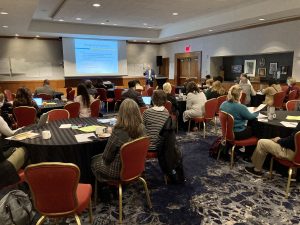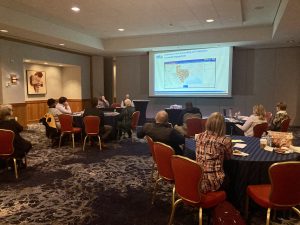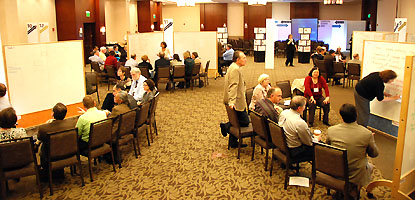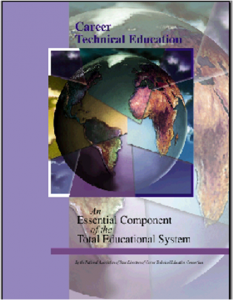 Last month, Advance CTE hosted the National Summit on Advancing Postsecondary CTE Data Quality & Use (Summit). The convening was the capstone of a two-year initiative, supported by ECMC Foundation, to support leaders in five states in cultivating postsecondary data ecosystems that assist institutions in offering career pathways that meet learner interests and are aligned to good careers. This post shares some of the main takeaways and themes from the Summit.
Last month, Advance CTE hosted the National Summit on Advancing Postsecondary CTE Data Quality & Use (Summit). The convening was the capstone of a two-year initiative, supported by ECMC Foundation, to support leaders in five states in cultivating postsecondary data ecosystems that assist institutions in offering career pathways that meet learner interests and are aligned to good careers. This post shares some of the main takeaways and themes from the Summit.
Individuals from twenty states and territories, as well as national partner organizations, attended the Summit to hear lessons learned from the Advancing Postsecondary C Data Quality & Use Initiative (PDI), explore promising practices to improve the quality and use of postsecondary CTE data and discuss strategies to sustain the work into the future.
The agenda of the Summit followed the unique approaches the PDI grantees took to improve postsecondary Career Technical Education (CTE) data quality and use, from aligning non-credit courses to credit, improving data visualizations and creating new data elements to capture work-based learning or learners’ needs.
 The Summit also celebrated high-quality data system achievements outside of the PDI cohort. The first plenary featured a panel of Anna Fontus, Program Officer, ECMC Foundation; Su Jin Jez, Executive Director, California Competes; and Paige Kowalski, Executive Vice President, Data Quality Campaign. The panelists spoke on effective strategies to build support for California’s P20 Cradle-to-Career Data System, including:
The Summit also celebrated high-quality data system achievements outside of the PDI cohort. The first plenary featured a panel of Anna Fontus, Program Officer, ECMC Foundation; Su Jin Jez, Executive Director, California Competes; and Paige Kowalski, Executive Vice President, Data Quality Campaign. The panelists spoke on effective strategies to build support for California’s P20 Cradle-to-Career Data System, including:
- Cultivating buy-in from the governor;
- Building coalitions among the public to advocate for a state longitudinal data system;
- Creating an inclusive governance structure, and;
- Grounding the data system in the state’s key needs.
Overall, the panelists made clear that extensive planning and legislation enabled the state’s implementation to go relatively smoothly.
 The second plenary session was delivered by Delaware’s State CTE Director, Jonathan Wickert. Jon spoke to the change management that enabled major shifts in the state’s postsecondary CTE data practices and system. At the center, Delaware prioritized building buy-in among staff and institution-level leaders and practitioners through many rounds of listening and feedback sessions. The state put itself in the seat of convener and let its stakeholders guide the principles and questions that would be addressed by new data routines and system requirements. This work resulted in a shared mission statement, principles and research agenda that ensures stakeholders and users needs are met by data system improvements.
The second plenary session was delivered by Delaware’s State CTE Director, Jonathan Wickert. Jon spoke to the change management that enabled major shifts in the state’s postsecondary CTE data practices and system. At the center, Delaware prioritized building buy-in among staff and institution-level leaders and practitioners through many rounds of listening and feedback sessions. The state put itself in the seat of convener and let its stakeholders guide the principles and questions that would be addressed by new data routines and system requirements. This work resulted in a shared mission statement, principles and research agenda that ensures stakeholders and users needs are met by data system improvements.
Over the course of the two-day convening, common themes emerged across the plenary, concurrent and interactive sessions:
- State legislation has enabled states including Maryland, Kentucky, Florida and California to quickly build buy-in and sustain momentum for developing statewide data systems.
- Inclusive, collaborative working groups convened by states including California and Delaware are powerful for ensuring states’ key priorities are identified early on.
- Professional development for state and institutional leaders and practitioners is crucial to change beliefs and expectations around postsecondary CTE data quality and use.
Through the PDI, Advance CTE has worked with the Alabama Community College System, Delaware Department of Education, University of the District of Columbia Community College, Florida Department of Education and Oregon Higher Education Coordinating Commission to develop and implement comprehensive action plans to improve the quality and use of postsecondary CTE data.
Learn more about the PDI grantees’ work and lessons learned through the initiative’s series of mini briefs here.
Candace Williams, Data & Research Manager


 Â
 


 Welcoming OVAE leadership: The Fall Summit was kicked off by the new leadership of the Office of Vocational and
Welcoming OVAE leadership: The Fall Summit was kicked off by the new leadership of the Office of Vocational and Adult Education at the U.S. Department of Education, Assistant Secretary Brenda Dann-Messier and Deputy Assistant Secretary Glenn Cummings. Both were generous in their time, taking the opportunity to circulate the room and meet Summit attendees. Brenda and Glenn demonstrate genuine commitment to advocate for public policy that helps more students be successful.
Adult Education at the U.S. Department of Education, Assistant Secretary Brenda Dann-Messier and Deputy Assistant Secretary Glenn Cummings. Both were generous in their time, taking the opportunity to circulate the room and meet Summit attendees. Brenda and Glenn demonstrate genuine commitment to advocate for public policy that helps more students be successful. He shared that “(t)his country has been engaged in an ongoing discussion about education and now, more than at any other time, our leaders are absolutely convinced that education is the make or break element in our nation’s arsenal of tools. But at the same time there appears to be less of a consensus about what constitutes a proper level and extent of education.â€
He shared that “(t)his country has been engaged in an ongoing discussion about education and now, more than at any other time, our leaders are absolutely convinced that education is the make or break element in our nation’s arsenal of tools. But at the same time there appears to be less of a consensus about what constitutes a proper level and extent of education.â€

 ummit?   CTE is at a critical juncture. Many policymakers, national organizations and leaders are looking to CTE to be a partner and a solution in both the educational and workforce arenas. This recent interest has created an opportunity for us to challenge current beliefs and assumptions, break down silos, broaden perspectives, increase rigor and build systemic support for CTE.
ummit?   CTE is at a critical juncture. Many policymakers, national organizations and leaders are looking to CTE to be a partner and a solution in both the educational and workforce arenas. This recent interest has created an opportunity for us to challenge current beliefs and assumptions, break down silos, broaden perspectives, increase rigor and build systemic support for CTE.
 this may seem like a lofty goal, it is not without precedent. In the 1998, under the leadership of Dr. Mike Rush (who was then the State Director in Idaho) NASDCTEc put out an epochal document –
this may seem like a lofty goal, it is not without precedent. In the 1998, under the leadership of Dr. Mike Rush (who was then the State Director in Idaho) NASDCTEc put out an epochal document –